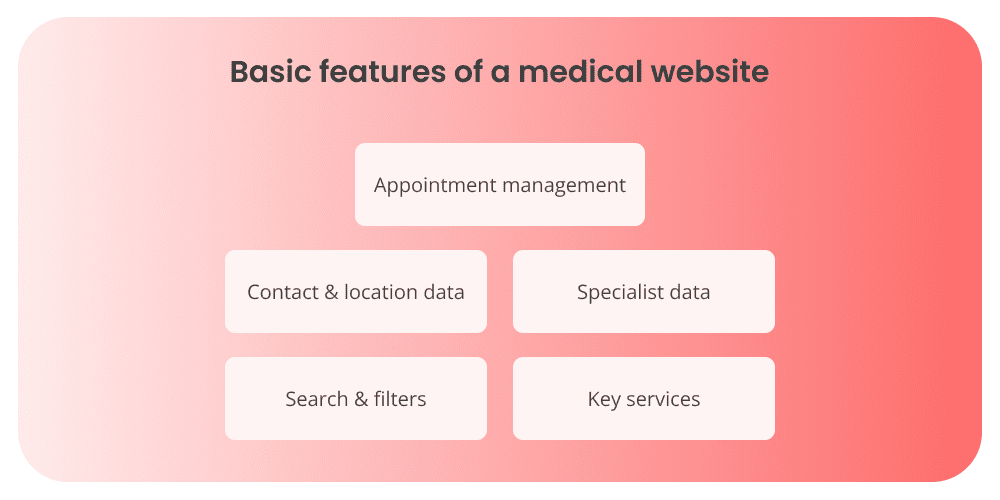Digital transformations in numerous industries, including healthcare, are propelled by modern technologies. In today’s world, having a website is essential for hospitals, as people have high expectations. A good patient experience necessitates a convenient and user-friendly medical site. Keeping these factors in mind, we have created a comprehensive guide on healthcare website design and development. This guide can also help you evaluate CodeBright as an IT service provider for creating healthcare web solutions that comply with key industry-specific regulations.
Medical Web Design Trends
Cluttered and disorganized websites tend to drive clients away. Users want to quickly find the information they need, so the website should be easy to use and navigate. Trends change rapidly, making it challenging to stay current. Here are some of the most recent innovations in healthcare website design for 2023.
User-centric design
User-centered design takes into account the user’s needs throughout all stages of development. This approach ensures that the design process is shaped and guided by user behavior, values, and expectations. Every design solution is assessed based on its usefulness to the user and its effectiveness in helping them achieve their objectives.
Flat design
Flat user interface design employs minimalist and concise elements, resulting in a simple yet striking design that focuses on the website’s content. Flat design can reduce loading times, as it incorporates simpler design elements.
Micro animation
Micro animations are small animated parts of the user interface that help draw users’ attention and enhance website navigation. However, they should not overwhelm the website but rather complement its functionality.
Hamburger menu
The hamburger menu is a button located in the top corner of a website interface, which, when clicked, provides access to the main menu or navigation bar. Hamburger menus are popular because they take up less space and prevent a cluttered navigation bar from distracting users from the website content. Moreover, they work well on mobile devices, making websites more user-friendly.
Bright colors
Colorful designs are one of the most significant healthcare website design trends of 2023. Bold and rich colors are in style, and you can choose multiple corporate colors to represent your brand. For example, orange symbolizes optimism, while blue signifies trustworthiness. Therefore, it’s important to consider color palettes during healthcare website development.
Icon branding
Icons can effectively represent your brand and make it more memorable. Each icon should be consistent with others in the set and linked to the brand to maximize the impact of this trend.
As you can see, users anticipate clean and colorful websites with animations in the near future. Many healthcare website design firms can create a website design that meets your requirements and business objectives. CodeBright also offers UI/UX services – check out our Dribbble account to see how we incorporate these trends.
Medical Website Development: Features to Implement
When embarking on healthcare website development, you should think about the features you want to incorporate. Generally, these are divided into two categories — basic and advanced. The basic features are essential for your website to function properly, while advanced features offer exciting functionality that enhances user engagement.
Basic Features
Let’s begin by exploring the critical features of healthcare website development.
 Contact & location information
Contact & location information
It should be easy for users to find a hospital’s location or phone number on a healthcare website. If you have multiple locations, ensure users can choose the nearest one. Phone numbers should be prominently displayed, preferably on the homepage. For example, you can integrate a click-to-call button, allowing users browsing the website on mobile devices to call directly from the site.
Key services
It’s crucial for clients to easily find information about the services your hospital offers. If you provide unique services, your UI/UX designers should consider ways to highlight them. For example, website developers can include a list of services with clickable links to access more detailed information.
Team
Patients are often interested in learning about their doctors, so it’s a good idea to provide information about the specialists. You can include details about their education, experience, and more, which can help build patients’ trust and loyalty.
Appointments
Scheduling should be as simple as possible. Provide users with options to choose the date, time, and doctor, and allow patients to fill out a request form with their name, insurance, phone number, symptoms, and other necessary information.
Search
When visiting your website, clients should easily find the information they need and learn more about your services. The primary goal of healthcare website design and development is to create a user-friendly search function. It’s also helpful to incorporate filters and enable users to sort search results based on different criteria.
Advanced Features
In addition to basic healthcare website features, you can implement several advanced features to enhance user experience.

Chatbots
Chatbots can be invaluable for your business, as they can quickly provide answers to frequently asked questions about hospital hours, locations, and more. This reduces the workload on your administrators and call centers.
Call-to-action button
Pop-ups can be used to offer users the option to schedule an appointment or find a suitable doctor. This allows users to access these features without searching through the navigation bar.
Online payments
Once an appointment is booked, patients should have the option to pay for the service online. It’s a good idea to include multiple payment methods (e.g., PayPal, Visa) during healthcare website development while ensuring security measures are in place.
Online consultations
Offering the ability for patients to consult with a physician online is beneficial for both new and existing patients.
Feedback
Clients appreciate the opportunity to share their experiences by leaving testimonials. Positive feedback can help build trust with potential patients and attract new clients to your hospital.
We’ve covered the main features that can be integrated during healthcare website development. Basic features are typically considered MVP (minimum viable product) features, as they meet patients’ needs. We recommend developing an MVP version of the website and launching it. Based on user feedback, healthcare website designers and developers can implement more complex features.
Specifics of Medical Website Development
To succeed, it’s important to choose the right tech stack during healthcare website design and development. Additionally, ensure compliance with regulations such as HIPAA or HITECH, which protect patients’ health information. These rules are also applied when building EHR systems and other medical software.
Let’s discuss these guidelines more precisely.
Comply with regulations
Compliance with regulations is crucial for any medical software, especially healthcare website development. There is no universal regulation for all solutions, so your website must meet various requirements and laws depending on the location and other factors, such as HIPAA and HITECH for the USA, PIPEDA for Canada, or GDPR for European countries. Before developing your medical product, make sure to review government regulations.
Ensure privacy policy
Healthcare website development deals with sensitive data, so a strong privacy policy is essential. Work with an experienced software vendor who can implement security measures and create a privacy policy that is clear and understandable to all users. This policy should outline what data is collected, how it’s processed and encrypted, and how it’s protected.
Get an SSL certification
During healthcare website development, HTTPS and SSL certificates are required to provide a secure connection to the server and encrypt all transmitted data. Certificate costs vary depending on the level of protection and the number of domains. Your software provider can recommend the best option for your needs.
Take care of easy navigation
Healthcare website design and development demand a unique approach. Your site should be intuitive, allowing users to easily navigate and access the information they need. An experienced UI/UX team will create an optimal, customer-centric design for you.
Ensure your website is responsive
It’s essential that your healthcare website looks and functions well on any device, as many users prefer using mobile gadgets. Web developers must ensure that your website maintains its quality appearance and performance across all devices.
Medical Web Development: Steps to Bring Your Idea to Life
Medical website design and development typically involves several sequential steps to ensure the most effective product creation. Let’s examine these steps in detail.
1. First contact
Begin by choosing a company with relevant expertise and submit an application on the vendor’s website, outlining your project’s main concept. Within 24 hours, a Delivery Manager will contact you to schedule a consultation and a team meeting. You may also request an NDA to keep your app idea confidential.
2. Solution design stage
At this stage, you’ll meet with the medical web development team to discuss your key business objectives, work scope, primary constraints and concerns, and essential quality attributes. The Solution Design team consists of a business analyst, a solution architect, and a designer.
3. Discovery phase
During this phase, software experts transform the agreed-upon requirements into a medical website development plan. The team performs the following steps:
- Identifies all regional regulatory requirements
- Creates a detailed feature list
- Analyzes business processes and generates required documentation
- Conducts a quality attributes workshop
- Prepares an exact cost estimate for the project, and more
Utilizing Discovery services can help expedite the medical website design and development process and increase efficiency.
4. Design and prototyping
The UI/UX design team focuses on creating an intuitive design concept to provide the best user experience. They develop a prototype of the future medical website, screen by screen, considering all minor details. After your approval, the design is sent to development.
5. Development and QA
Frontend and backend developers work on the project, ensuring the site functions correctly and efficiently while using the appropriate technology stack. Developers may use APIs to integrate third-party services, making the medical website more functional.
Quality assurance is an essential component at each development stage to ensure seamless and error-free operation of all features. Once the web development is complete, QA engineers conduct comprehensive regression testing.
6. Launch and support
After the medical website design and development work is completed, the site can be launched. The team moves the website to the live server and provides you with all project materials, including links, specifications, and design details. Your collaboration with the software provider continues as you update the website, add new features, and address potential bugs based on customer feedback.
Tips to Find Medical Website Developers
There are two potential collaboration methods with medical website developers: in-house or outsourcing. Each option has its pros and cons. Today, many companies choose outsourced medical web development due to its numerous benefits. Here are some tips to help you select the best software provider:
- Decide on the outsourcing region
- Study customer reviews
- Learn more about the vendor
- Discuss communication
By considering these factors, you can find a reliable software provider that will deliver high-quality medical website design and development services.
Practical Experience in Medical Web Development
CodeBright is a software services company with over a decade of expertise. We develop web solutions that streamline processes, modernize outdated software, and enhance user experiences. Our professionals utilize top-notch technologies to create solutions that align with business objectives and comply with regulatory standards, ensuring seamless, error-free performance and secure data handling and transmission. Contact us today to learn how we can develop a web application for you.


